All Stages of the Marketing Funnel | Understanding The Buyer Journey
by Joseph Jones • June 14, 2022
If the marketing funnel looks more like a tornado to you, don’t worry! The marketing funnel can seem mysterious and overwhelming, but it’s really just a simple model for tracking the customer’s journey.
We’ll help you understand what it is, how it works, and how to make the most of it as a tool for fostering sales and, hopefully, brand loyalty.
We’re going to go over the stages of the marketing funnel and what types of campaigns can benefit you in each. In this article we’ll cover:
- What is the marketing funnel?
- What is AIDA?
- Why the shape of the marketing funnel is important
- The stages of the marketing funnel
- Marketing funnel strategies (campaigns)
What is the Marketing Funnel?
The marketing funnel is the marketer or seller’s terminology for a buyer’s journey. It can be broken down into simple and recognizable stages, starting with the first time a consumer is aware of a product and ending with a loyal customer.
While there are many ways to describe the marketing funnel stages, most include: initial awareness of your product or service; a period of consideration; interest and research; desire to purchase; a purchase, subscription or app install; and lastly, loyalty and/or advocacy.
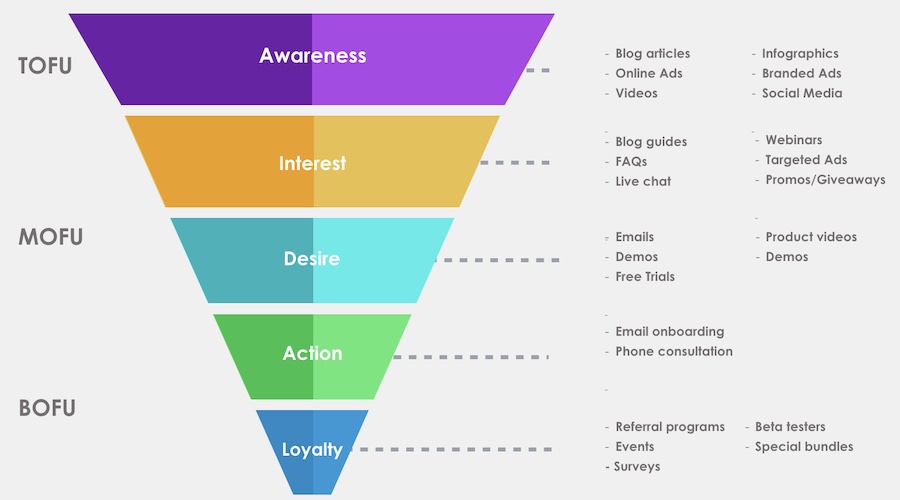
What is the AIDA Model?
The original model for the sales funnel was developed by Elias St. Elmo Lewis. He was a businessman who, in 1898 developed what is known as the AIDA model. Although it has been built on and changed over the years, the basic idea is the same. His initial model included the following steps:
Awareness. A customer becomes aware of your product, service or brand. This can be the result of word-of-mouth or advertising.
Interest. A consumer gains interest in your product and might conduct some research and comparisons. Some also call this the consideration phase.
Desire. The consumer develops a want or even a need for your product or service.
Action. The consumer purchases your product or service.
It might seem pretty basic, but this model is incredibly valuable when you know how to make the most of the touchpoints that occur in each stage.
Why the Shape of the Marketing Funnel is Important
There is visual significance in the marketing funnel. The wide end of the funnel represents attempts to reach a large and varied audience. Like casting a really wide net, this stage is meant to generate awareness among pretty much everyone, or at least less “qualified” leads than the ones you will reach in later stages of the funnel.
As the funnel gets more narrow, the leads or audience you are reaching correspondingly narrows (becomes more niche). These are the people who are most likely to want, need, and purchase your products and services. The end of the funnel represents the customers who make it through all the stages of the funnel.
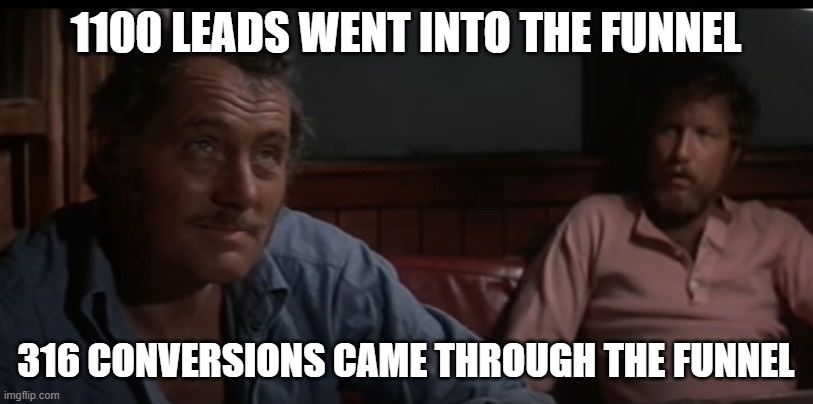
Founder of MECLABS, Flint McGlaughlin, states that there is danger in seeing a funnel in the typical right-side-up way. He says this suggests that leads and customers just kind of trickle down or fall into the funnel, like a net or bowl.
Not so, he argues!
The funnel needs to be seen as inverted so the idea of diligently pushing leads and customers upward is understood. Think of it like a ladder, where the customer is working against gravity to make it to the top of the funnel.
Every single touchpoint you have with a potential customer needs to be carefully nurtured. Leads don’t fall into your lap, they are captured through strategic campaigns and efforts that we will cover below.
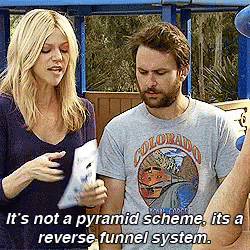
Stages of the Marketing Funnel
Let’s dive deeper into the stages of the marketing funnel and then discuss the strategies you can use in each one.
By the way, if you are in ecommerce or sell anything online, this will often be called the “digital marketing funnel.” As most products and services require some form of online marketing, you can consider them one and the same. Some also like to see each stage as a funnel of its own. This helps to drill-down on all the unique touchpoints of a particular stage of the whole or full-funnel approach.
Stage 1: Awareness (or Discovery)
The discovery stage of the marketing, or “awareness funnel” is when users first become aware of your brand. They hear about you from a friend, see a Facebook Ad, or come across a Shopping Ad while they’re researching online.
Many customer acquisition campaigns start at the discovery stage, with the goal of connecting with cold (also called broad or unqualified) audiences that they can capture (or at least capture their interest) and push to the next stage.
Stage 2: Interest (or Research and Consideration)
This is the part of the customer journey where the user is considering and researching both your brand and product in-depth along with other competitors for comparison.
It’s important to give users plenty of information about what makes your brand and product different, which builds understanding and trust.
Stage 3: Desire
This is the stage of the funnel where your potential customers get beyond mere interest and now feel a want or need to have your product or service. This presents a critical point where you want the potential customer to take quick and decisive action.
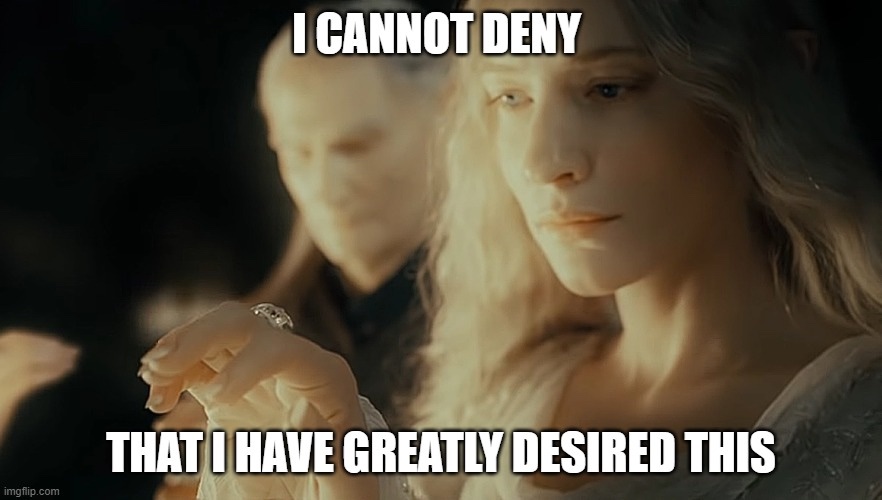
Stage 4: Action/Purchase
Also referred to as the “sales funnel,” this is the stage that many businesses focus on most. During the purchase stage of the marketing funnel, users make the decision to buy and then do so.
This is obviously a crucial part of the funnel, where you can recap the value of all the campaigns you’ve created so far and land a new customer.
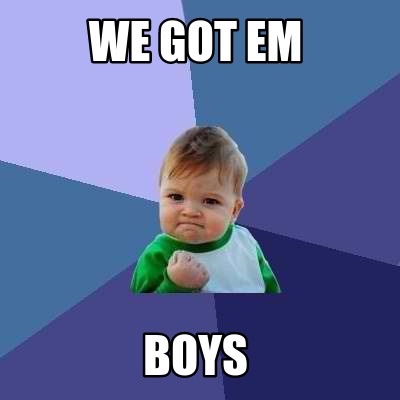
Stage 5: Loyalty, Retention & Advocacy
Okay we added onto the OG model because this ongoing stage of the funnel is as critical as the preceding ones.
This stage of the funnel focuses on building ongoing relationships with your customers. Your focus will shift from getting them to make a purchase to your brand being their preference.
Customer acquisition is expensive, after all, and it’s much more cost-effective to retain customers than it is to acquire them. This is particularly true since many repeat customers are willing to spend more and buy more often because the trust is there.
When you can get your customer base to promote and advocate for your products and services, you know you’ve got it right.
Marketing Funnel Strategies/Campaigns
Okay, we’ve covered the basics and now you know what each of the important stages of customer funnels are all about. Now we’ll talk about some of the campaigns or strategies that you could be using for each of these stages.
Types of Campaigns to Consider in the Discovery/Awareness Stage
To create strong touchpoints at the discovery stage of the digital marketing funnel, you can test the following types of campaigns:
- Run ads on Facebook, LinkedIn, or Pinterest that use lookalike audiences created off of high-value custom audiences to reach new users who are demographically similar to existing customers.
- Set up Google Search Ads to capture high-intent traffic that’s starting their buying process.
- Have referral programs in place to leverage the momentum you already have, letting your existing customers help you find new customers.
- Build SEO through content marketing to expand reach (and rank for a ton of keywords).
- Start posting on social media, using reach-focused practices like including hashtags on TikTok and creating Reels on Instagram.
Types of Campaigns to Consider During the Interest/Consideration Stage
These are the best types of campaigns to create for the research and consideration stage of the sales funnel:
- Run retargeting ads to show offers or Lead Ads to users who have viewed different pages of your site or clicked on past ads.
- Create lead magnets like checklists, ebooks, or webinars that are designed to offer information and capture the lead’s name and info while building trust.
- Have an email opt-in box on your site and focus on product information sharing through email.
- Have free trials for B2B and SaaS products; this is crucial, and in some cases, even eCommerce brands are using this strategy with “free trial of products”.
- Share UGC—including reviews— on your site, in emails, and on social media to build trust.
Types of Campaigns to Consider During the Action/Purchase Stage
Ready to drive purchases from engaged audiences? Time to seal the deal. These are the types of campaigns you should consider implementing right away:
- Retargeting campaigns focused on resolving the user’s pain point.
- Email campaigns that offer a discount, especially for abandoned-carts or first-time visitors.
- Continually running great intro offers that are highly visible on your site, either through pop-ups or banners or both (think free audits, free consults, free tours, free first classes, 15% off, and more).
Pro tip: A seamless checkout process (which ideally offers some Instant Pay options) is crucial to getting sales.
Types of Campaigns to Consider During the Loyalty/Retention Stage
Keep users engaged and purchasing with the following campaign options that are well-suited to the loyalty and retention stage of the marketing funnel:
- Take things full circle and have referral programs marketed to these customers, incentivizing them to share more and then buy more with special discounts.
- Create re-engagement campaigns through both email and social media ads reminding users to buy again, or trying to re-engage dropped-off customers with discounts after a set period of time.
- Take advantage of cross-selling and up-selling, showing customers recommendations for products based on past purchases.
Final Thoughts
There you have it— the stages of the marketing funnel, and a few types of campaigns that you should consider implementing for each one. It’s always important to have multiple touchpoints at each stage to make sure that you’re capturing as many users as possible.
All successful marketing strategies account for the entire funnel so that you can appeal to users no matter where they are in the process. This helps create stronger individual touchpoints that also work better together as a whole.
Some, for example, will start their process on Google Search Ads, while others may not even know they need a product or service like yours until someone tells them about it. Having expansive campaigns at each stage and throughout the funnel, as a result, is the only way to grow your client list and your revenue at scale.
Need help optimizing your campaigns for a full-funnel approach? Our top-rated digital marketing agency specializes in helping our clients create a strong marketing funnel so that the ads we run are sure to get results. Make sure you get a free audit before you leave.





